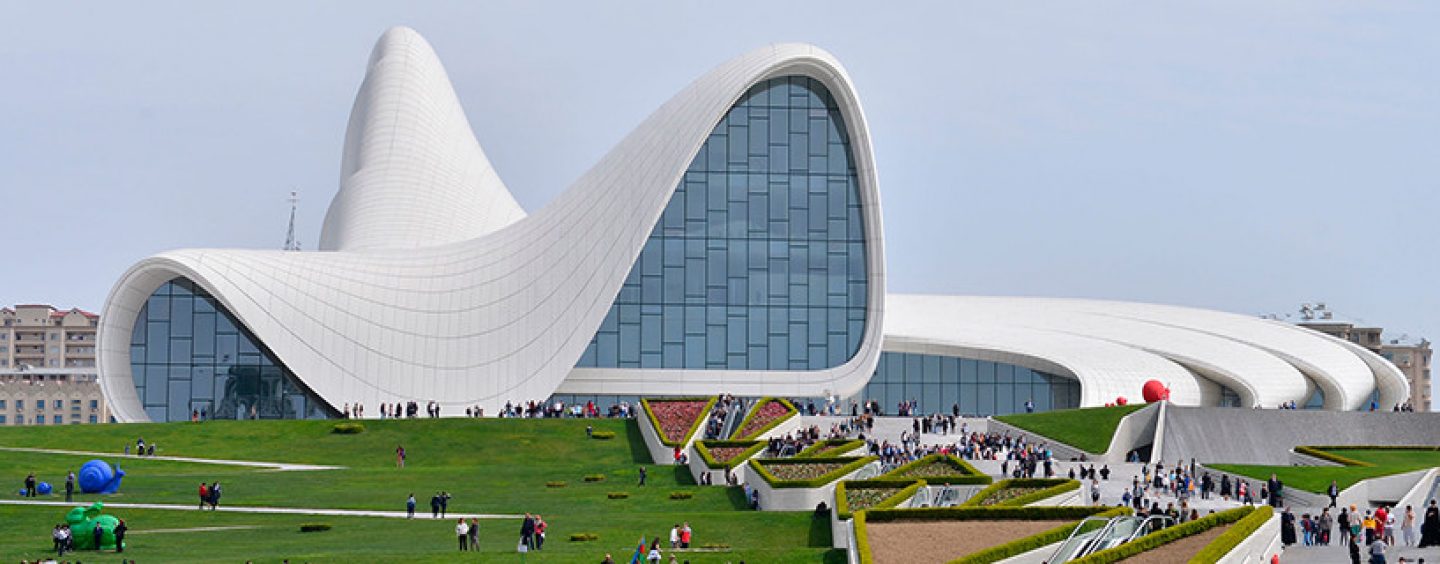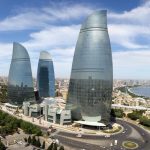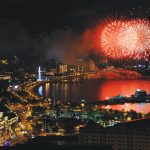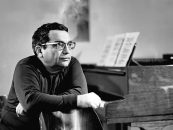Modern-day Baku meets the most exquisite expectations of tourists traveling from various parts of the world with anticipation to see historical monuments and state-of-the-art architectural buildings. The capital of Azerbaijan bears an imprint of cultures and historical events ranging from the dawn of civilization to the latest achievements of the country of Flames. In Baku, tourists can find numerous historic sites that are included in the UNESCO World Heritage List.
The name of Baku goes back to Zoroastrianism, and is associated with the word “Bhagwan” that implies “the place of God.” The second version of the capital’s name is consonant with Persian words “Bad Koube,” translating as “winded through”. Both options characterize Baku – known to many of those who visited the capital of Azerbaijan – as an ancient pilgrimage destination for followers of the pristine religion of Zoroastrianism, as well as the “City of Winds.”
Appealing historical monuments
Since ancient times, historical sources portrayed Baku as a locality where inextinguishable fire flames were burning all the time. The sanctuary of Zoroastrians, worshipers that came here to worship the sacred fire, was situated in the Surahani district of Baku. Presumably, this first sanctuary dated back to as early as first century A.D.
An “everlasting” fire unquenchably burned at the Ateshgah temple – built in the 17-18th centuries A.D. right where natural gas came close to the ground surface – which served as the temple of fire.
Around the 2nd and 3rd century A.D., the present-day temple replaced ancient temples attended by Zoroastrian fire-worshipers. In the 17th century A.D., a chapel, 26 cells and a Caravanserai were built nearby the temple. At the time, the cells provided fire priests with necessary conditions for the fulfillment of various religious rites. As the pilgrims visited this temple, they could take rest at the Caravanserai facility. In early 18th century A.D., the temple was given an outward appearance that it has maintained till present.
The memorial’s inner court has a pentagonal shape that, in turn, surrounds an elevated quadrangular structure of the central altar, whose upper part is covered by a cupola. In keeping with Apsheron tradition, the guest room called ‘Balahani’ was located above the porch. Built in compliance with new times’ architectural traditions, the Ateshgah temple still managed to retain the traits of a pristine fire altar. The Caravanserai, representing the temple’s oldest edifice, dates back to 1713, and contains inscriptions in Sanskrit.
After restoration and reconstruction, the Atashgah Temple was, on 29 March 2013, reintroduced to tourists as the National Historical and Architectural Reserve. The Monument has been included in the UNESCO World Heritage List.
Arriving in Baku, our guests immediately fall in love with the city as they walk along the Seaside Boulevard situated on the coast of Baku bay. By the way, the map of Ptolemy, the 2nd century A.D., portrayed Baku that was distant from the sea. From the 7th century through to the 9th century A.D., the sea level had been constantly surging which, subsequently, initiated the Baku Bay formation process. Significant changes took place in late 13th century, when the Caspian Sea level rose by more than ten meters. A geographer by the name of Abd al-Rashid al-Bakou wrote in 1403 that the Caspian Sea flooded a part of Baku and came to splash at the base of the Maiden Tower. In the course of the following 600 years, the sea level fluctuated but remained quite high until the 20th century, when it began to recede.
The Seaside Boulevard – one of Baku attractions – is a favorite place enjoyed by Bakuvites and guests of the city. In 2009, the Boulevard has celebrated its 100th year anniversary. In 2007, a unique musical laser show fountain was launched at the Seaside Park, opposite ‘Azneft’ Square. In 2008, construction of yet another musical fountain entitled ‘Seven Beauties’ was completed over opposite of the Government House.
One of the Boulevard’s most beautiful sections, founded in the 1960s and called a ‘Small Town of Venice,’ was completely remodeled in 2012. National ornaments decorate the “little town,” whose parts are connected by new bridges built over the town’s canals. While maintaining its former appearance, the ‘Small Venice’ has been enriched with new elements: its channels were broadened, deepened, connected to water passages and floated by new boats.
Western and Oriental cuisine is offered to guests of the capital by the town public catering facilities. In the evening time, the lighting system – installed along the canals, bridges and tunnels – embellishes the small town making it look even more beautiful.
In March 2014, a new Ferris wheel was opened to the public in the the new boulevard section of the National Seaside Park. With 60 meters in diameter, the structure has 30 passenger capsules, each accommodating 4 persons.
Whereas the park’s current length totals 5 km 600 meters, its future redevelopment will increase its total length to 25 km.
Icheri Sheher (Inner City)
An architectural complex depicting the living legend of Azerbaijani history, the Icheri Sheher, is one of the world’s unique monuments to enjoy. Archeological excavations conducted here have shed light on previously unknown aspects of national statehood and revealed historical facts confirming strategic importance of ancient Baku located on the Great Silk Road. In 1985, the Icheri Sheher was attributed the status of the State Historical and Architectural Reserve of Azerbaijan Republic, and in 2000, the Inner City was included in the World Heritage List by UNESCO.
Arousing great interest of tourists, it is Caravanserai that represents one of the most significant historical buildings in Icheri Sheher. The Caravanserai reveals an important attribute of ancient oriental life.
The Palatial ensemble of Shirvanshahs was built in early 15th century A.D. Comprising a set of monuments, the ensemble occupies the peak point of Icheri Sheher.
Built in early 15th century, the Shahs’ Mosque was founded as a religious worship site in the lower courtyard of the fortified city. The mosque area does not exceed 70 square meters, which is a clear witness of a small number of people that came here. The Mosque’s picturesque shape comprises a refined and tall minaret coupled with two domes – large and small.
The sepulcher of Shirvanshahs’, the ‘Turbe,’ is seen next to the Shahs’ Mosque. An inscription is found over the entrance aperture reporting that this tomb was built by Shirvanshah Khalilullah in 839 of Hegira (1435-1436 A.D.) for his mother and son. Later, the vault building was used to house the madrassa.
The eastern wall of the fortress includes a portal called the Gate of Murad. It was built when Baku was conquered by Turks. The “Mausoleum of the dervish” is situated in the southern part of the courtyard.
Baku Palatial ensemble is the most unique and perfect monument, whose architecture embodies the best features of the artistic style of the time. The Palace includes a History and Architecture Museum, which is considered one of the richest museums in Baku. The museum’s exhibits are displayed both throughout the ensemble buildings, palace chambers and open-air sections.
The Maiden Tower is situated in proximity to the Palace. This unique monument’s foundation was laid back in the 7-6th centuries BC but later, in the 12th century A.D., it underwent another remodeling. The tower is 28 meters high with its diameter totaling 16-16.5 meters. It comprises a cylinder-shaped citadel and a large abutting edifice on the south side.
There is an inscription at the entrance that reads: “The Tower of Masood, the son of Davud.” Constituting a unique piece of our national architecture, the Maiden Tower represents a historic symbol of Baku that was also included in the UNESCO World Heritage List.
Its inner museum exhibition reveals legends on the Maiden Tower. The exhibition refers to hypotheses and scientific research regarding the role the Maiden Tower played as a defensive facility. Also, the museum stands display samples of ancient combat weapons.
Broad consideration is given to the assumption that the Maiden Tower played the role of an ancient observatory. There is an opinion that it was primarily built to monitor solar rotation patterns throughout the year and to explore the highlights of this process.
Oil, the Nobels, Azerbaijan’s Millionaires and Benevolent Sponsors
The oil boom of mid-18th century largely contributed to the visage of Baku. It is true that, even in the Middle Ages, the city acted as the focal point of regional oil production. Abd ar Rashid Al Bakuvi, a geographer that lived in the 14-15th centuries, used to take note of the fact that every day a caravan of more than 200 oil-laden camels would leave Baku, each carrying about 300 liters of oil.
But the first Azerbaijani oil boom occurred in the middle of the 18th century, and it was actively participated by the ‘Petroleum Production Company’ owned by the Nobel Brothers. It were namely those brothers that made their fortune by extracting and trading Baku oil and founded the world famous Nobel Prize.
In Baku, the Nobel brothers built a family residence and a settlement called ‘Villa Petrolea’ for their company employees. Up to date, their residence has been renovated to accommodate a museum of the Nobel brothers.
The Nobel brothers had actively contributed to the construction of the Lutheran Kirche (Church) in Baku. Architect Adolf Eichler employed Gothic Revival style to design the German Church. On March 21, 1896, its foundation stone ceremony was attended by Immanuel Nobel, his stepmother and the second wife of Ludvig Nobel. On June 24, 1898, a gilded cross weighing 213 kilograms was installed onto the building’s tall fleche. In early 1899, the church was supplied with bells and organ. Its consecration ceremony – held on 14 March 1899 – brought together more than a thousand people. Its first organ music concert took place on April 23, 1900; it consisted of musical pieces by Johann Sebastian Bach.
At present, the former church is known as the State Organ and Chamber Music Hall of Azerbaijan State Philharmonic. Following its 2010 remodeling, the Kirche building, along with other Baku memorials, was attributed the status of a special architectural landmark.
Guests of Baku are destined to encounter many more magnificent Gothic style structures and buildings found in the city.
To perpetuate the memory of his son, the oil tycoon named Agamusa Naghiyev ordered construction of a palace, styled after Venetian Doges and called “Ismailie,” for the Muslim Charitable Society in Baku. Currently, this gorgeous building houses the Presidium of Azerbaijan’s National Academy of Sciences. Completed in 1913, the “Ismailie” is known to be the most magnificent single architectural structure in the city.
No less interesting is the fate of the Marriage Registration Hall that was built by yet another oil magnate by the name of Murtuza Muhtarov. Designed in the spirit of French Gothic style, the building was apparently designed to become the Palace of Happiness, according to a legend which says the oil lord intended this building to become a gift to his young wife. M.Muhtarov could not have overlooked the admiration his young wife had for the architectural beauty of Venetian buildings. And in 1912, the Azerbaijani oil lord had, secretly from his wife, acquired drawings in order to raise a “twin” palace in Baku.
Every guest of the city should be shown, and told about, the house that belonged to Haji Zeynalabdin Tagiyev, an oil magnate well renowned for his benevolence. Built in 1895-1901, the palace, designed by Polish architect I.Goslavsky, looks pretty beautiful both in terms of its grandeur, huge cupolas on the roof and because, currently, it is known as the Azerbaijani history museum.
Our foreign guests will be interested to know about the Azerbaijani Literature Museum, built in the Soviet days, whose architecture clearly exhibit vivid motifs of Azerbaijani architecture. Deep inside a six-arch stanza, one can see statues of prominent Azerbaijani writers and poets that represent a kind of pantheon of national luminaries; including a monument to Nizami Ganjavi, whose establishment was timed to celebration of the poet’s 800th year anniversary.
New Symbols of Baku
The new symbols of Baku include the State Flag Square, Fairmont Hotel Baku that is coupled with the ‘Flame Towers’ and Heydar Aliyev Center.
On 1 September 2010, the state flag of Azerbaijan was solemnly raised at the public inauguration ceremony dedicated to the National Flag Square. Since then, the State Flag Square boasts the highest flagpole in the world, which is why it was included in the Guinness Book of Records.
The Square upper part’s area totals 3 hectares. Its overall area, however, amounts to 60 hectares. The Square exhibits the following state symbols of Azerbaijan: the emblem, text of the anthem and the country’s map. The National Flag Museum was also established at the Square. Its flagpole is 162 meters high, so it can be seen from anywhere in Baku. Great parks and Baku Seaside Boulevard are found nearby the Square, where people can enjoy excellent conditions for recreation.










